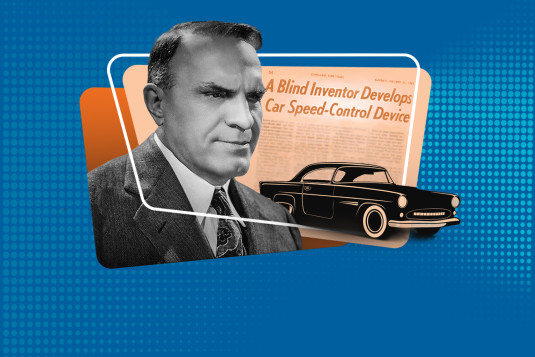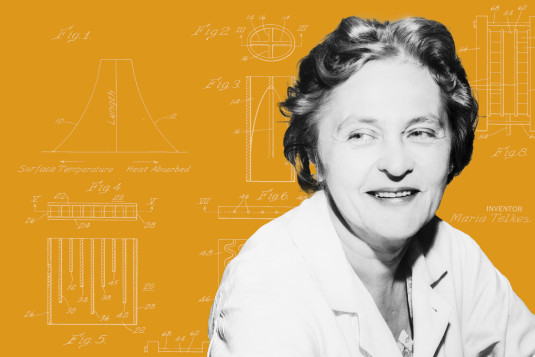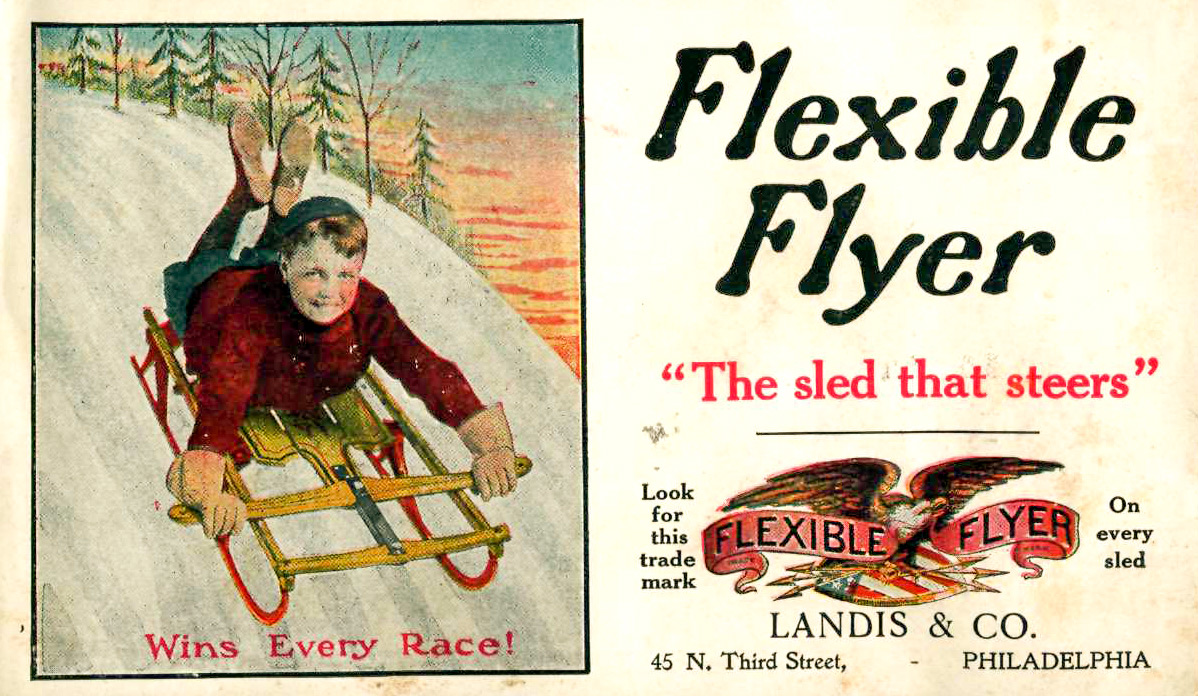
The sled that steers
In the 1880s, Samuel Leeds Allen reinvented winter with the Flexible Flyer, a sled on red steel runners that riders could steer with their hands or feet. A self-taught inventor, Allen knew he’d hit it big when the kids told him so.
14 min read
Each month, our Journeys of Innovation series tells the stories of inventors or entrepreneurs who have made a positive difference in the world. This month’s story focuses on Samuel Leeds Allen, the manufacturer and inventor who changed sledding forever.
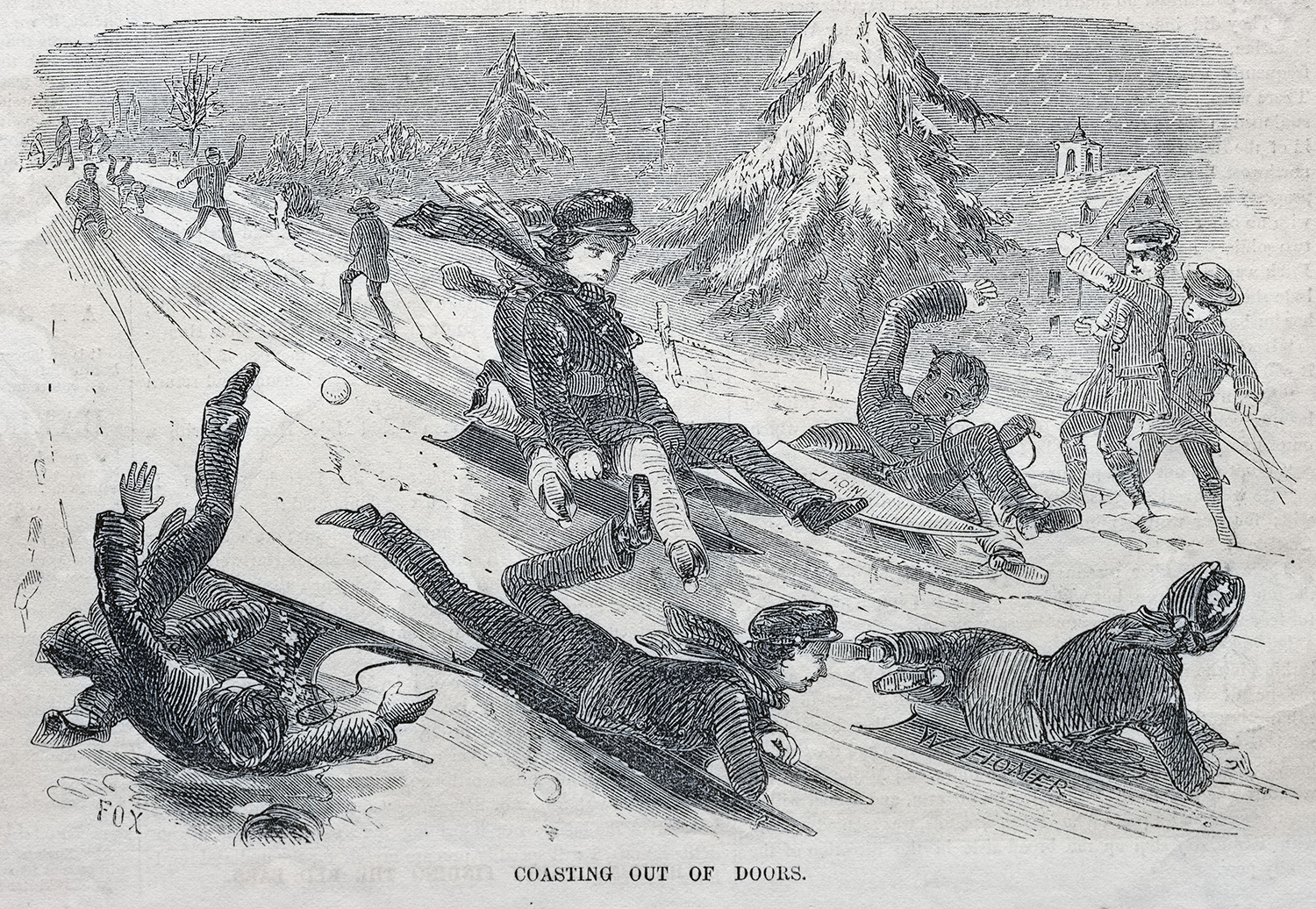
Winslow Homer’s 1857 wood engraving, “Coasting Out of Doors,” depicts the experience of sledding in the era before the Flexible Flyer, when sleds lacked built-in steering mechanisms. Courtesy of the Cleveland Museum of Art.
The inventor of the Flexible Flyer sled, Samuel Leeds Allen was the Victorian version of a winter sports enthusiast, especially when it came to “coasting,” the term for downhill sledding. The only way to steer a sled had been with a heel jammed into the snow—until, that is, Allen poured all his experience and energy into creating the country’s first steerable, mass-marketed sled.
Allen was born in Philadelphia on May 5, 1841, to parents Rebecca and John, a pharmacist. Allen took an early interest in mechanical devices. One of his first words was “unkerella,” for the umbrella that provided hours of exploratory entertainment at his father’s drug store. Soon, Allen graduated from the umbrella to kites and made 20 in one season. “I never saw anyone with so much perseverance,” his mother recalled. “He never seemed to give up on an idea.” A few years later, Allen was already experimenting with improvements on telescopes, alarm clocks, and ice skates.
The love of winter sports, especially those involving speed, foreshadowed Allen’s later claim to fame as the inventor of the Flexible Flyer. He spent winter days ice-skating on the Schuylkill River and winter nights in the back garden, where he and the neighborhood children built snow hills for use in the following day’s sled runs.
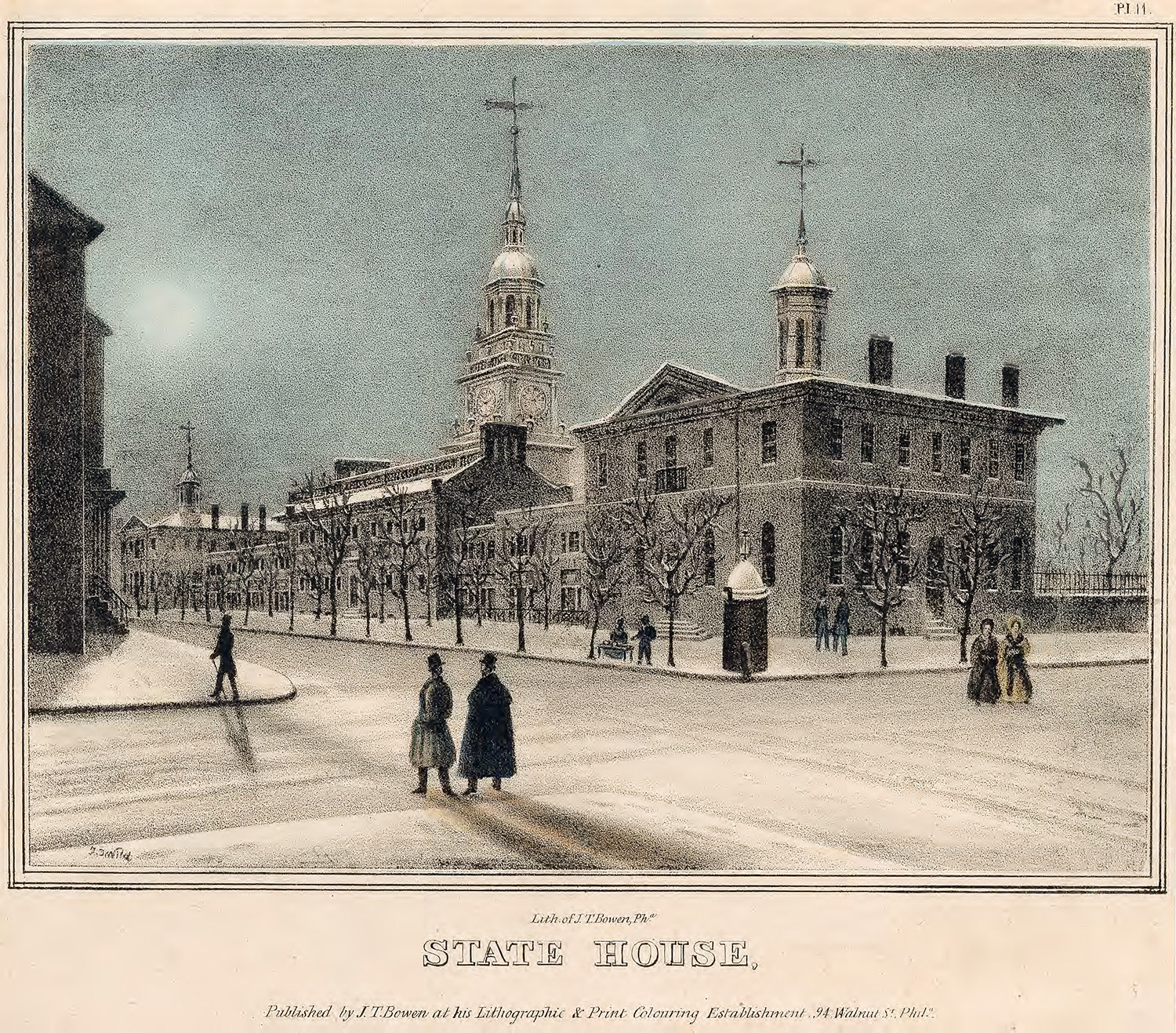
The Allens lived a short sledding distance from the State House (now Independence Hall) in Philadelphia, shown here from the corner of Chestnut and 6th streets ca. 1838. Lithograph by John Caspar Wild, collection of the Library of Congress.
In the 1840s and ’50s, American children (or the adults in their communities) tended to make sleds rather than buy them. Of those sleds available for purchase, toboggans were the norm, despite the existence of a few sleds with runners. None came with a workable steering mechanism. Nevertheless, Philadelphia children like Allen made do and availed themselves of this golden age of urban sledding. With no motorized traffic on the roads and no reliable means of quick snow removal, a single snowstorm could transform the city’s grid of streets and alleys into a wintry free-for-all. Children outside the cities had even more opportunities to coast downhill on slicks of snow and ice.
Frozen hills abounded around Westtown School in Chester County, Pennsylvania, which Allen attended as a boarder from age 11. He was not a good student in the traditional sense and complained to his cousin, “I believe I can’t study lessons like other boys, and the teacher says I’m lazy.” Allen’s actual problem was not laziness but a passion for experiential learning that put him too far ahead of the pedagogy of his day. He spent so much of his free time inventing and experimenting that the other students referred to him as the scientist in residence.
Allen finished his formal education at age 14 and transferred to the farm of a relative in New Jersey. The move reflected Allen’s father’s belief that practical experience outdoors would build character and cultivate virtue. The clear air and wholesome company of the countryside appealed to parents like Allen’s father in mid-19th-century Philadelphia, then one of the largest and fastest-growing cities in the world, booming and filthy and rife with temptations and dangers for teenage boys, as the older generations saw it.
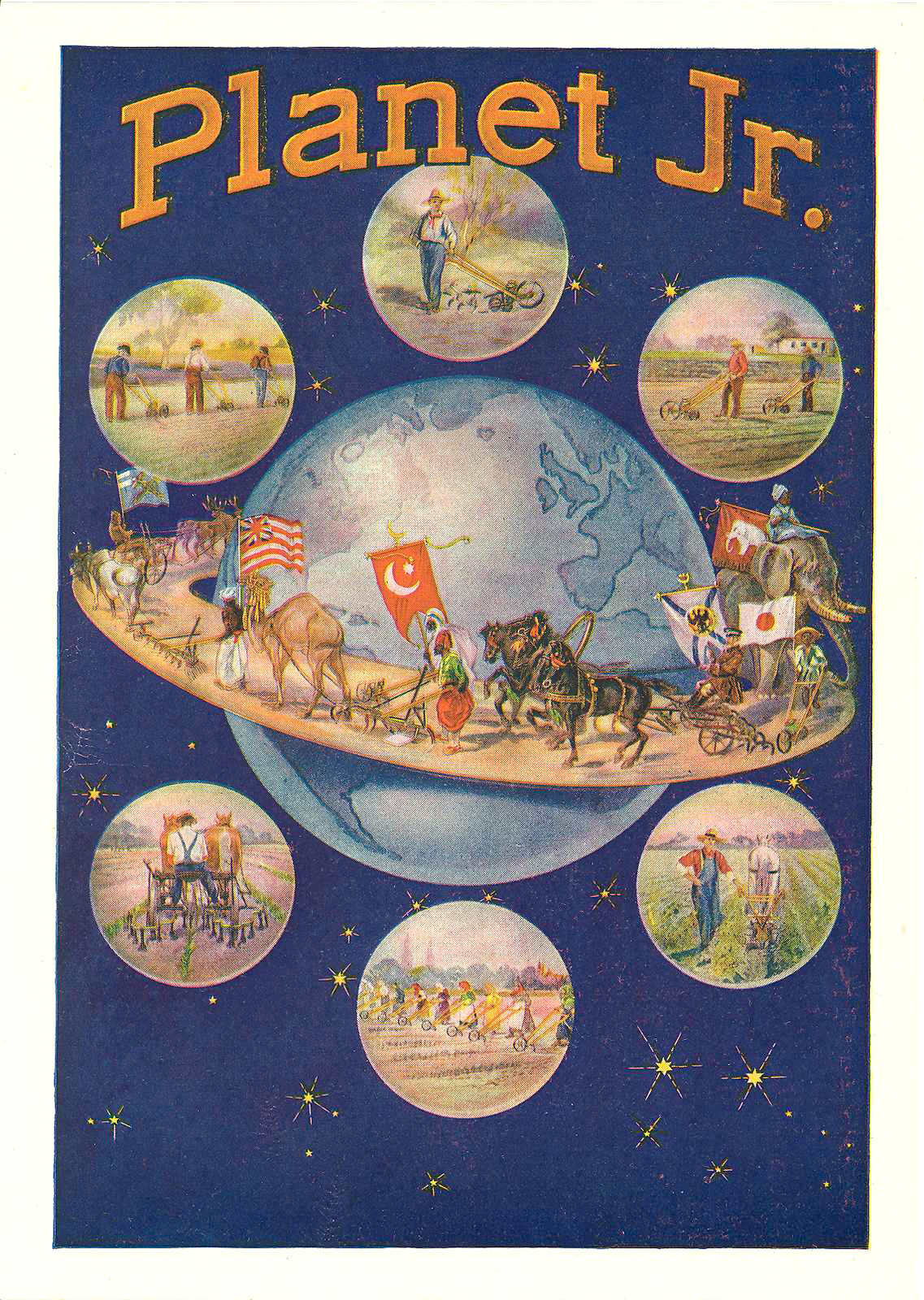
This late-19th-century print advertisement for the Planet Jr. line of farm implements attests to Allen’s creativity in advertising. Courtesy of the Hagley Museum and Library.
As Quakers, the Allens prized simplicity and rural calm, even more so at the dawn of the industrial age. For the younger Allen, agricultural work presented opportunities for innovation, especially after 1861, when he took over a farm belonging to his father near Westfield, New Jersey, and married Sarah Hooten Roberts, a member of the Allens’ extended Quaker community. In their early years of marriage, and amid the births of six children, Allen’s wife witnessed and supported her husband’s transition from amateur to professional inventor.
The breakthrough came in September 1866, she recalled, when “Samuel drove me home ... [and] told me he had invented a fertilizer drill for spreading guano.” He called his invention the “Planet Drill” for its resemblance to the ringed planet Saturn. Shortly thereafter, he invented a seed drill and called it “Planet Jr.” These two devices eventually pushed Allen to the forefront of the cultivator industry. From that vantage, it was an easy, if unexpected, transition to the Flexible Flyer.
For the first two decades of its existence, however, Allen’s firm, S.L. Allen & Co., headquartered in Philadelphia, limited itself to agricultural implements and machinery. As president of the company, Allen perfected his skills in advertising and marketing. He traveled by rail around the mid-Atlantic region, promoting his wares at fairs and to farmers’ associations. He reached still wider markets through persuasive print advertisements. Amid regular ad runs in agricultural publications, Allen even had original pamphlets, books, memorabilia, and periodicals printed and distributed across the United States and eventually overseas. One of them, a periodical called “Farm and Garden,” reached a circulation of 50,000.
“Mr. Allen was always a firm believer in advertising,” one of his employees remembered. “He combined inventive genius with great business ability, an unusual combination.” In marketing the company’s large line of products—garden seeders, wheel hoes, plows, harrows, corn shellers, feed grinders, dusters, cultivators, and lawn mowers—Allen managed to “tell his story” in engaging prose and believed that “these early advertisements were the best pullers we ever got,” according to an associate. The “tremendous” outlay on advertising paid off in the 1880s and poised Allen and his firm for the publicity blitzes that would make the Flexible Flyer an American classic at the end of the century.

Allen was not the only adult to enjoy sledding. In this 1886 advertisement, Star Toboggans of Chicago appealed directly to grownups in search of winter fun. And yet, when it came to steering, riders were on their own. Collection of the Library of Congress.
Another factor in the company’s successes was intellectual property protection. Lucrative patents for “cultivator-frames” (U.S. Design Patent Nos. 19,367; 19,449; 19,713; and 30,069) became company assets and the subject of advertisements from 1889 onward. Each reflected the inventive activities of Allen himself, still the company’s principal visionary.
“I do not remember that he ever complained of the difficulties he had encountered from a lack of training,” Allen’s wife Sarah recalled. With no formal education past early high school, Allen had a way of speaking of his own accomplishments “with surprised wonder ... as if he scarcely understood how he had been able to achieve so much.”
Allen invented devices for his wife and children, too, not for profit but to improve and enrich the family’s daily life. To make it easier to administer quinine pills, a Victorian mainstay and defense against malaria, he invented a “pill-shooter.” The children actually enjoyed the process, when he would line them up against the wall and, to use his daughter’s own words, “shoot the pills down our throats.” The “gun” wasn’t a gun at all but rather a “split stick with a pill in the cleft, so it sped down” what Allen called “the red lane ... so quickly we had not time to taste the bitter coating.” Other inventions were pure fun: whistles made from willow switches and darts made from apple tree suckers. As in his own childhood, but now for his children, Allen crafted ever sturdier kites, some in the shape of exotic birds, after the Japanese fashion, and tied to stakes in the lawn, where the children marveled at the objects’ “graceful curves in the varying breeze.”
Come winter, there was always sledding. Once again, Allen constructed slopes and courses, sometimes as long as a quarter mile, and joined his children in downhill sprees. It was here, on the frozen ground of the family home in rural New Jersey, that Allen and his sons and daughters began to experiment in earnest with improvements on the tradition of sledding.
What had begun as a game turned into a systematic, almost scientific inquiry. After the day’s runs, Allen would mend and re-ice the course so that it would be ready the next day for one of his daughters to conduct her experiments. “I was expected to continue the trial,” she remembered, “while the surface still held, or until school time, and to give a clear report and criticism” on Allen’s return from work in the evening. “All the sleds preceding and including the ‘Flexible Flyer’ were tried out” in this way, according to Allen’s young researcher-in-chief.
Enjoying sledding as much as any of his children, Allen also had a business reason for developing and manufacturing sleds. Demand for agricultural implements was unpredictable, with farmers tending to wait until they had sold a season’s crop before ordering new tools and equipment. To fulfill these orders in a timely fashion, Allen’s workers stayed busy in the fall, winter, and spring but had little to do in the summer months. Some such summers, Allen’s factory closed entirely and then had to rehire workers in a rush when the orders picked up again. Not everyone returned, however, and the cost of training new workers weighed on the company every fall.
To mitigate the summer exodus, Allen needed a new line of wares. Recognizing that the summer interval was the high season in the wholesale market for toys, skates, skis, sleighs, and sleds, Allen decided to apply his inventive energies to improving one of these products.
Sleds made the most sense, especially some kind of steerable sled with metal runners. The component parts—wooden seat, steering lever, metal trusses—also constituted the Planet Jr. line of cultivators. The firm’s workers already had the skills and machinery to make the Flexible Flyer even before Allen invented it. With some success, Allen might operate his factory year-round and retain all his skilled workers.
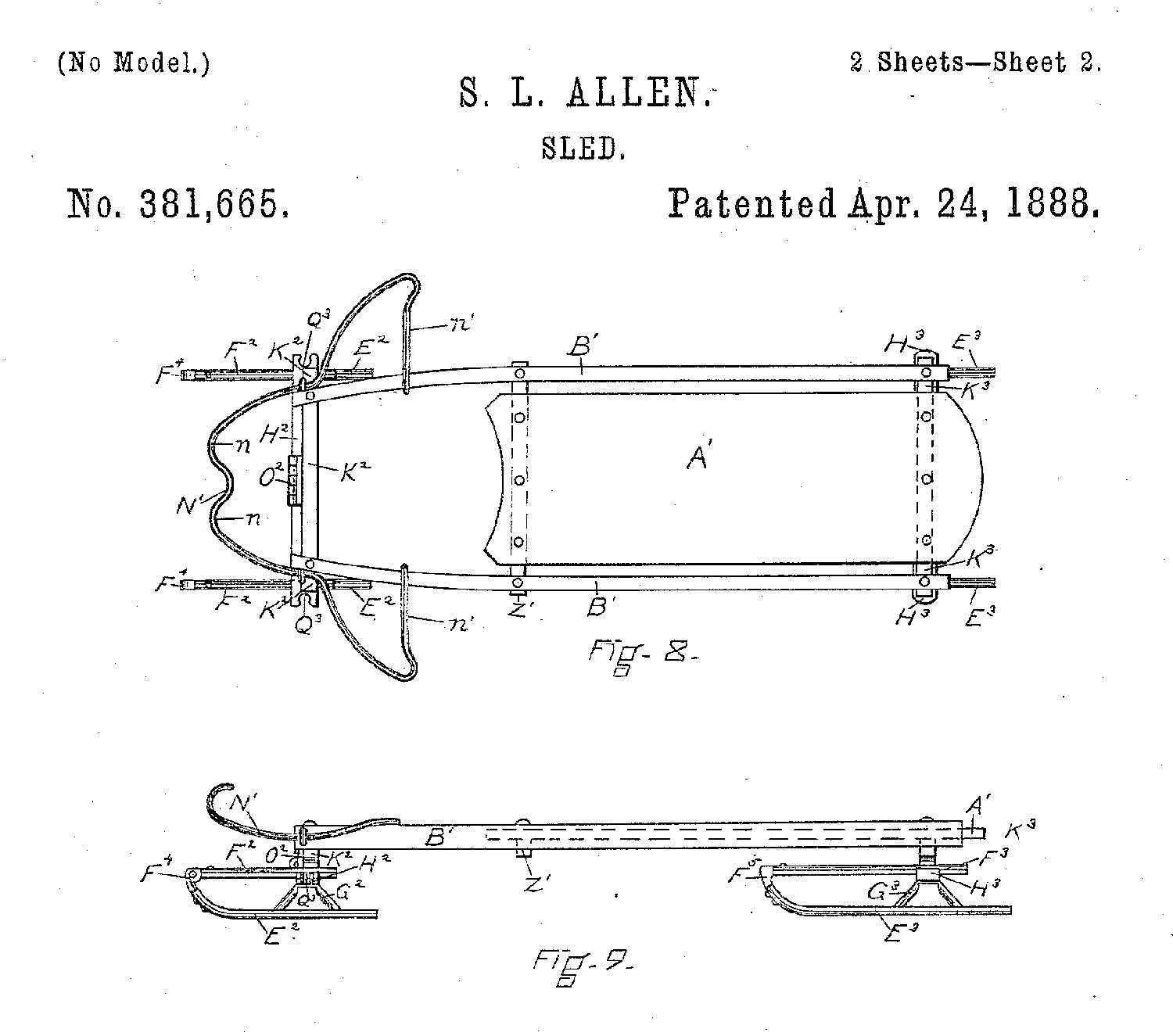
The “Fairy Coaster,” based on Allen’s first sled patent, was expensive and unwieldy, yet it offered lessons for the next iteration.
Allen’s first patented sled was the “Fairy Coaster” (U.S. Patent No. 381,665), which he finished in 1887. It accommodated at least three people on a plush seat supported by steel runners that could be steered by an intricate pivoting system at the front. A full braking system could be operated by levers. Unfortunately, the Fairy Coaster was costly to produce and expensive to own. The price, $50, equivalent to three to four weeks’ wages for a skilled laborer in Philadelphia, was beyond the reach of working Americans. The price also fell outside the range of what most middle-class Americans were willing to spend on toys.
As Allen tried to bring costs down by simplifying his invention, the Flexible Flyer began to take shape. Out went the Fairy Coaster’s upholstery and braking system. The sled’s four runners became two. The frame shrank. And yet, this modified Fairy Coaster was another bust. As Allen’s associate put it, “This new sled looked like a good proposition ... but on trying them out on the snow, they proved too small, not enough runner on the snow to steer properly.” When Allen sent prototypes to his alma mater at Westtown for the children to try out, they reported the same shortcomings. For Allen, it was back to the drawing board.
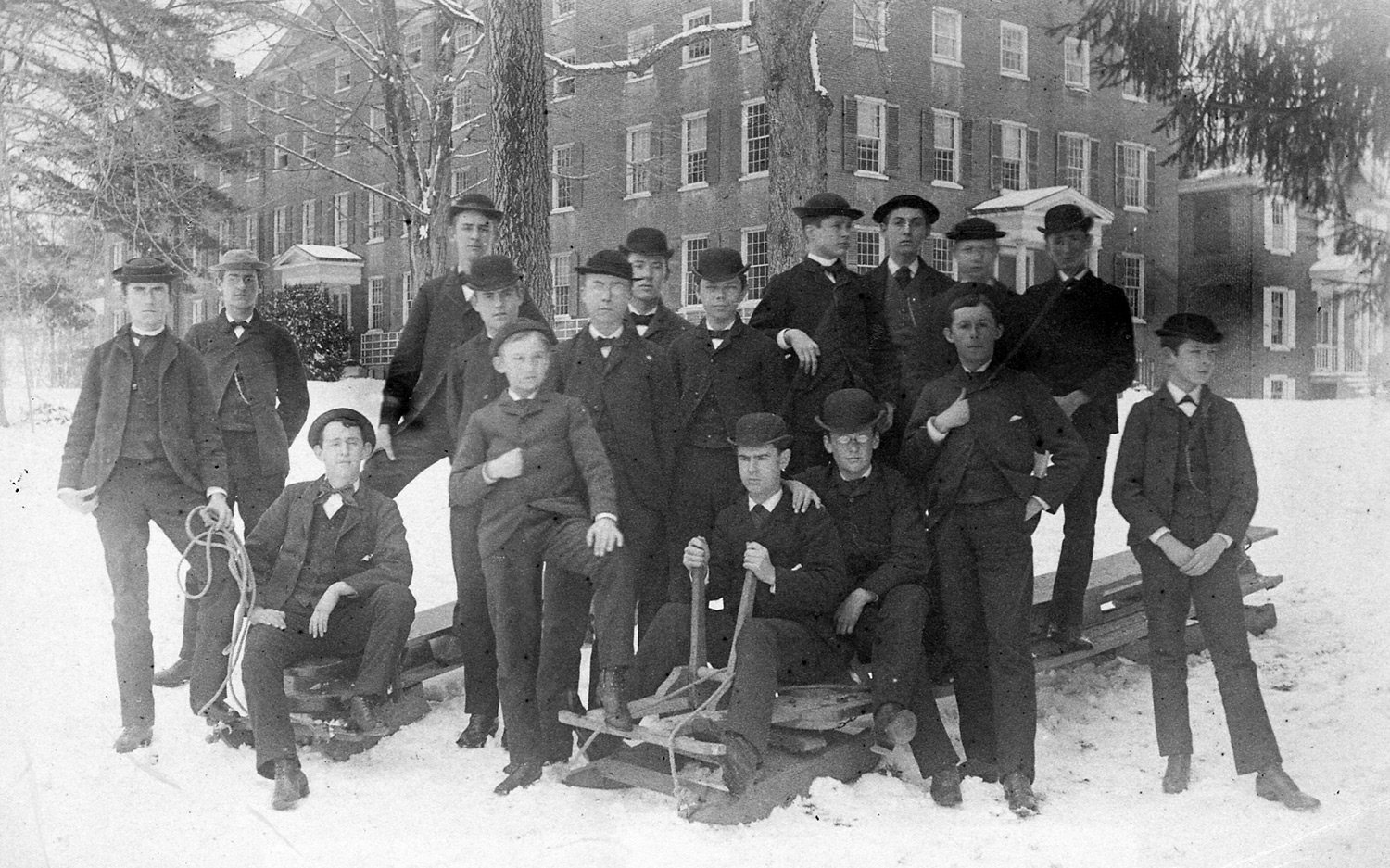
Allen sent his prototypes to Westtown School in Chester County, Pennsylvania, for testing in the late 1880s. Here, a group of Westtown boys handles large sleds with rudimentary steering mechanisms, likely unrelated to Allen’s lighter constructions of steel and slats. Courtesy of Westtown School Archives, West Chester, PA.
Allen had taught himself how to make technical drawings and had refined his skills over the years, having made most of the factory’s manufacturing plans himself. He kept pencil and paper handy and seldom shared an idea or a concept without the visual aid of an improvised sketch. When it came to arithmetic, Allen used his head: “The most difficult problems were usually worked out in his mind before the average person could put them down on paper,” one of Allen’s employees remarked. But Allen’s greatest asset, according to the same employee, was an “undying enthusiasm ... in ... experimental and inventive work.” Allen “seemed to have almost unlimited confidence that the new machine or improvement would be ‘the best ever,’ ‘way ahead,’ of anything previously made.”
Such turned out to be the case with Allen’s third try at reinventing the sled. In 1888, he finally landed on a prototype that worked. It consisted of a slatted seat on a pair of steel runners, with each runner split in two at a hinge. The back portions stayed fixed to the seat above, but the front runners, attached to a forward steering bar, could be directed left or right like the slanted sides of a parallelogram. In this way, the flexible front section cut a track through snow that the back runners would follow, all without sacrificing surface area and stability.
Prototypes went to Westtown School for the children and teachers to try out. They recognized this latest model as the best thing yet, “a complete creation,” “one of those marvels of mechanical simplicity which seemed incapable of improvement,” “the most wonderful of all his inventions.” In the Flexible Flyer, Allen offered maneuverability, speed, and durability in an affordable and lightweight sled, the first of its kind. He patented it right away (U.S. Patent No. 408,681). And yet, the Flexible Flyer did not become an instant classic.
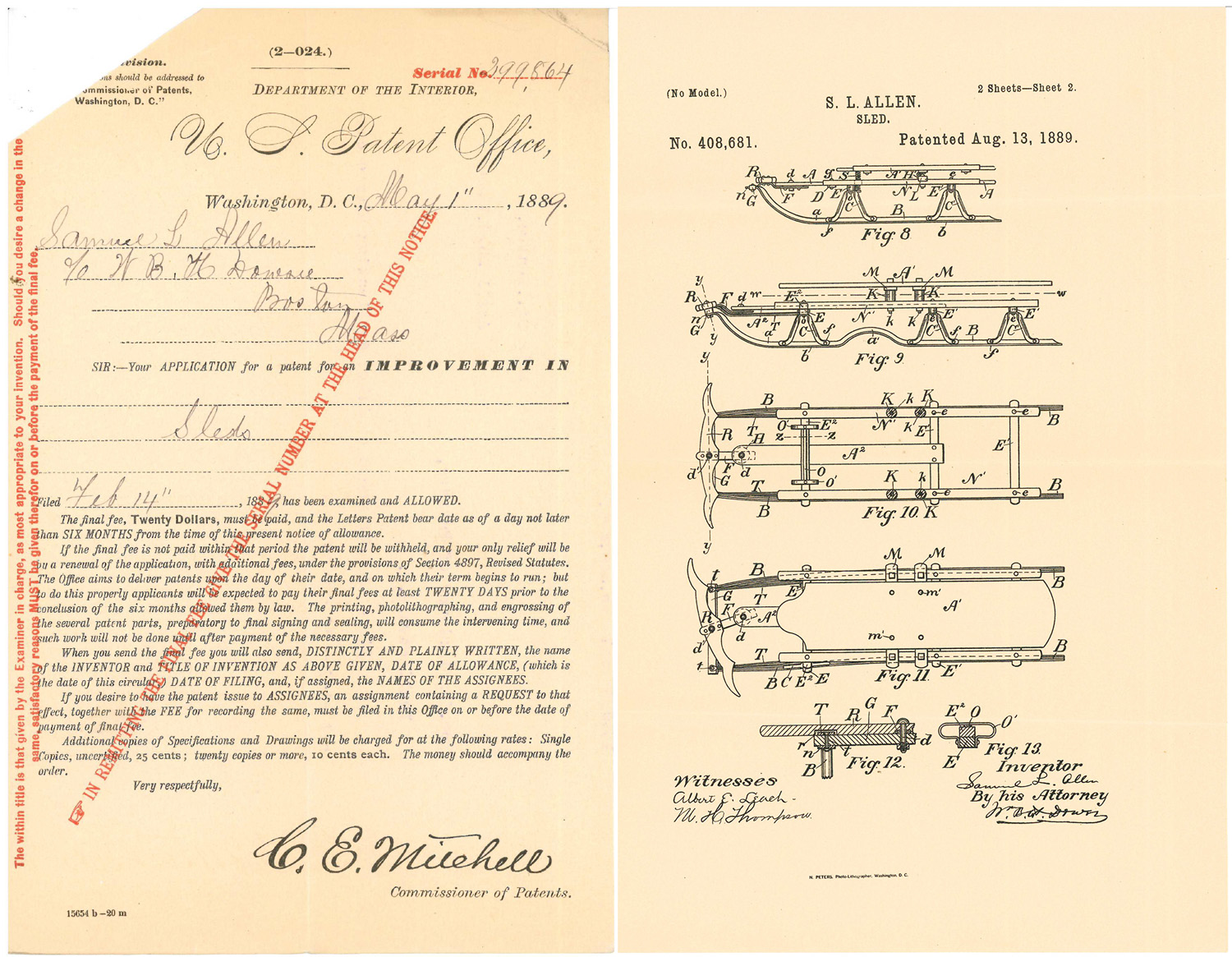
On May 1, 1889, the Patent Office sent notice (left) to Allen of his successful application for the Flexible Flyer patent (right). Courtesy of the National Archives and Records Administration.

Two girls take to a Flexible Flyer at Westtown School in the early 1900s. Courtesy of Westtown School Archives, West Chester, PA.
The children at Westtown knew a good thing when they saw it, to be sure, but not the big buyers like hardware and department stores. To these retailers, the Flexible Flyer looked too different from the familiar sleds and toboggans of their youth. Sales were so slow in the early 1890s that Allen’s senior staff recommended that he transfer the patent to another sled manufacturer, someone who could work the Flexible Flyer into a regular line of merchandise. But Allen held out.
As luck had it, certain cultural changes opened the market for Flexible Flyers around 1900. The 1890s were a period of transition in the culture of sporting. Tennis became popular, for example. Golf and golf courses proliferated. Skating and tobogganing increased. A complex mix of factors aided these developments: the growth of the middle class, the shortening of the workweek, and the decline of child labor, all of which increased the number of people with leisure time. These shifts expanded the market for things like sleds. Then there were calls from prominent social reformers to get people, especially children, outside and moving, with sports becoming the preferred antidote to the enervating effects of modern urban life. People heeded these calls in droves but needed the requisite equipment: balls, rackets, clubs, skates, and sleds.
Allen sensed this opening and stepped right in. From the mid-1890s, he began to spend great sums of money advertising the Flexible Flyer. It paid off. “The trade grew by leaps and bounds,” his staff observed, and “eventually,” according to the company’s vice president, “the ‘Flexible Flyer’ patent that was thought to have so little value by everyone but [Allen] became a very valuable asset.”
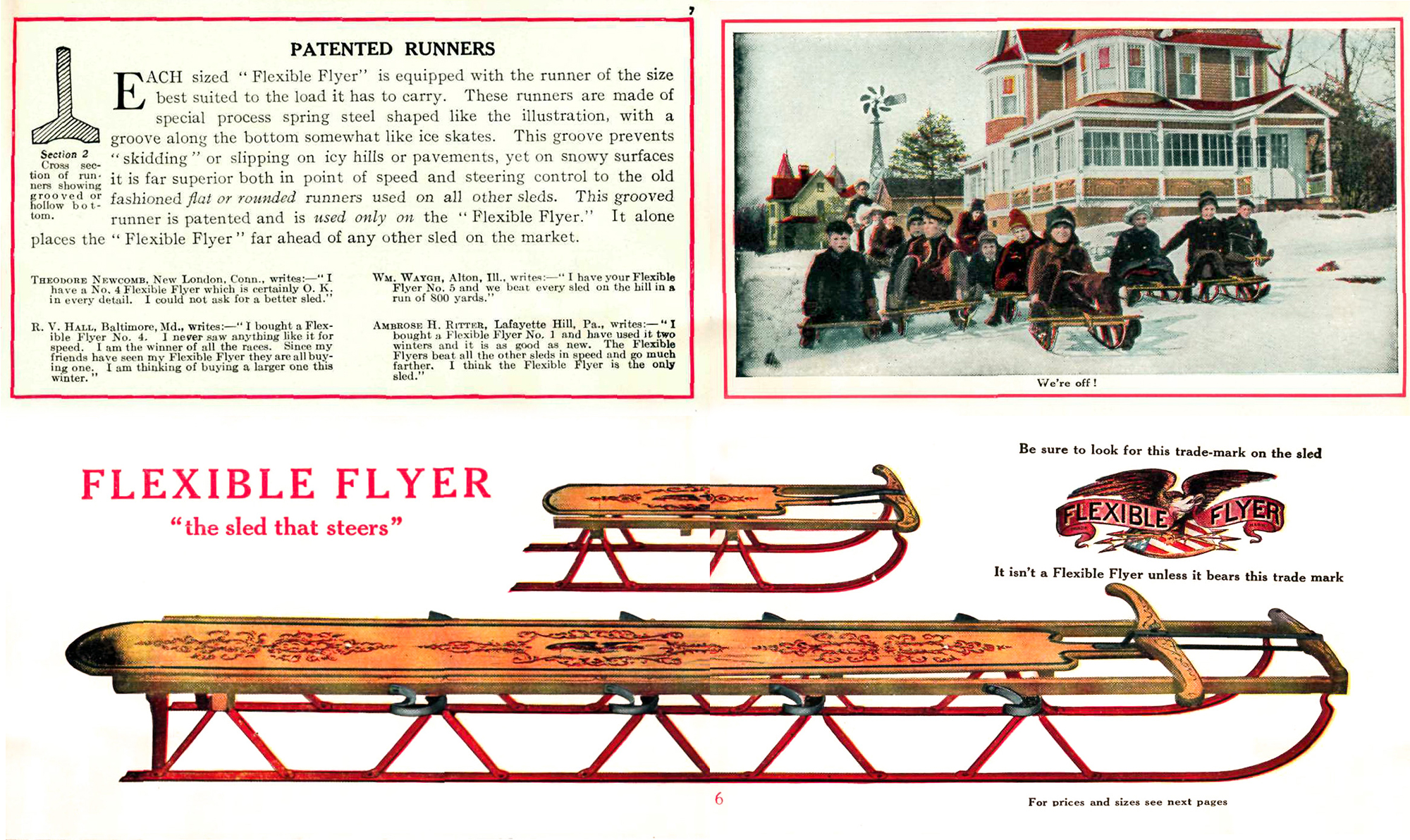
A promotional book of 1910 educates consumers on the intellectual property associated with the Flexible Flyer, by then available in several sizes. Courtesy of the Hagley Museum and Library.
Allen obtained still more patents related to the Flexible Flyer in 1904, 1905, and 1913 (U.S. Patent Nos. 797,165; 797,338; and 1,066,173), as well as trademark protections for the “Flexible Flyer” mark and “the sled that steers” slogan.
By the 1910s, Flexible Flyer was the best-known brand of sled, instantly recognizable in department stores, hardware stores, and toy stores, and on snow-covered slopes across the northern United States. “I have long regarded it as a special privilege,” one of Allen’s Westtown friends observed, that “a friend of mine should have furnished to the young people of our country such a means for enjoying one of the most exhilarating and healthful of all the outdoor pleasures”—the Flexible Flyer, as agile as it is fast, even still.
Allen’s firm and its assets are long gone, sold to other companies over the course of the 20th century. Eventually, as agriculture continued to industrialize, Allen’s farm implements passed into obsolescence. Only the Flexible Flyer remains, with two trademarks (U.S. Trademark Nos. 42,650 and 55,077) still active and registered to Paricon LLC of Maine, the family business doing brisk sales every year of Allen’s American original, “the sled that steers.”
Credits
Produced by the USPTO’s Office of the Chief Communications Officer. For feedback or questions, please contact inventorstories@uspto.gov.
Story by Adam Bisno. Contributions from Marie Ladino. Special thanks to Samuel Leeds Allen IV, Bob Beebe, Mary Brooks, Elizabeth Jones-Minsinger, Herrick Kimball, and Phil Snow. The image on the USPTO homepage was cropped from a photograph courtesy of Samuel Leeds Allen IV. The Flexible Flyer advertisement (ca. 1910) at the beginning of the story is courtesy of the Hagley Museum and Library.
References
Boyer, Paul S., Urban Masses and Moral Order in America, 1820-1920 (Cambridge, MA: Harvard University Press, 1992), 123-42, 162-90.
Dargan, Amanda, and Steven Zeitlin, City Play (New Brunswick, NJ: Rutgers University Press, 1990), 20-21, 95, 97, 152-53.
Davies, Richard O., Sports in American Life: A History, 3rd ed. (Malden, MA: Wiley Blackwell, 2017), 58-65, 69-70.
Freeman, Mark, introduction to Sport, Health and the Body in the History of Education (London: Routledge, 2015), 1-4.
Hardy, Stephen, “The City and the Rise of American Sport: 1820-1920,” Exercise and Sports Sciences Review 9 (1981): 183-219.
Mergen, Bernard, “Past Play: Relics, Memory, and History,” in The Future of Play Theory: A Multidisciplinary Inquiry into the Contributions of Brian Sutton-Smith, ed. Anthony D. Pellegrini (New York: SUNY Press, 1995), 258-61.
Riess, Steven A., City Games: The Evolution of American Urban Society and the Rise of Sports (Urbana, IL: University of Illinois Press, 1991), 252-59.
Roberts, Elizabeth Allen, ed., Samuel L. Allen: Intimate Recollections & Letters (Philadelphia: n.p., 1920), 13-17, 20-23, 26-28, 59-60, 62, 66, 71, 81, 83-84, 90-92, 95-98, 109-17, 122-23, 126, 129, 133-35, 149, 151-53, 164, 327-28.
Rzeznik, Thomas F., Church and Estate: Religion and Wealth in Industrial-Era Philadelphia (University Park, PA: Pennsylvania State University Press, 2013), 14-15, 115-17.


